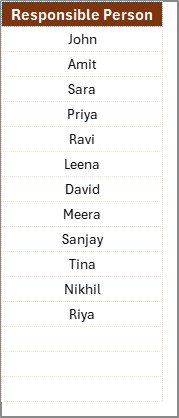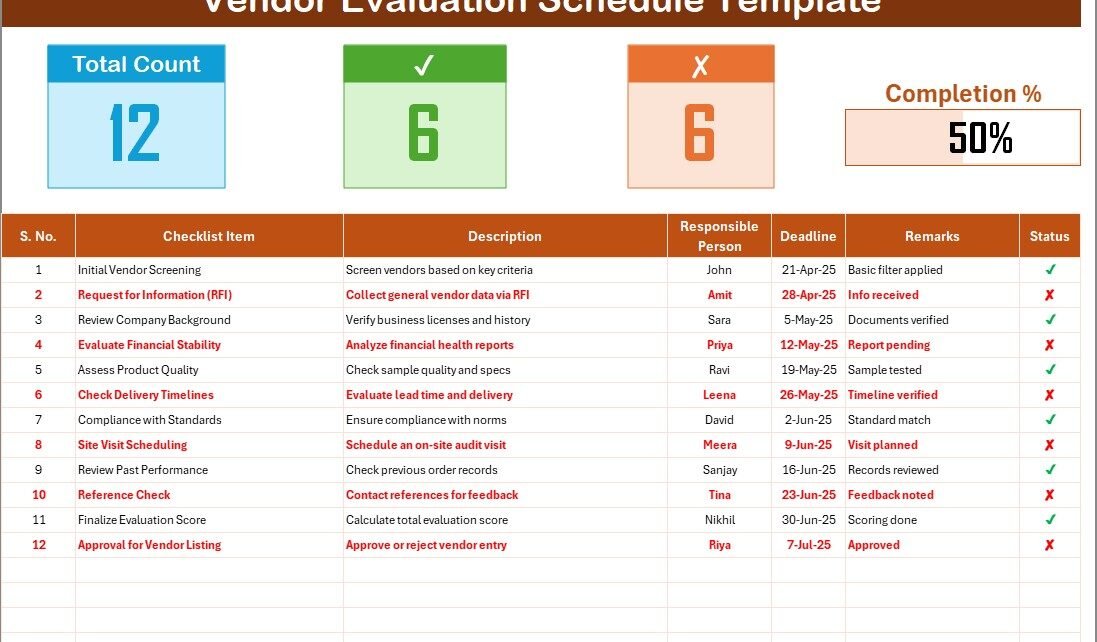Managing vendor performance is vital for business success, especially when you’re dealing with multiple suppliers. A well-organized Vendor Evaluation Schedule in Excel not only streamlines your procurement process but also enhances transparency, efficiency, and accountability. In this article, we’ll walk you through everything you need to know about creating, using, and benefiting from a Vendor Evaluation Schedule Checklist in Excel.
Click to Purchases Vendor Evaluation Schedule in Excel
What is a Vendor Evaluation Schedule?
A Vendor Evaluation Schedule is a structured plan that outlines the periodic review of your suppliers or vendors. It helps ensure your vendors meet your company’s quality standards, delivery schedules, pricing agreements, and compliance requirements. Using Excel to create this schedule allows flexibility, customization, and easy sharing across teams.
Why Should You Use Excel for Vendor Evaluation?
Excel remains a favorite for small to mid-sized businesses because:
- It’s easy to use and widely accessible.
- It allows automation and conditional formatting.
- You can customize checklists, dropdowns, and dashboards.
- It’s compatible with cloud tools like OneDrive and Google Drive.
Key Features of the Vendor Evaluation Schedule Checklist Template
This ready-to-use Excel template is thoughtfully designed to track and evaluate vendors in a structured manner. Let’s break down the main features:
Vendor Evaluation Schedule Checklist Sheet

This is your primary workspace.
Top Section Highlights:
- Total Count: Automatically counts total items in your checklist.
- Checked Count: Tracks completed items (✔).
- Crossed Count: Tracks incomplete or failed items (✘).
- Progress Bar: Visual indicator of overall completion percentage.
Main Checklist Table:
This section contains all evaluation items with the following columns:
- Serial No. – Unique identifier for each item.
- Checklist Item – The task or activity to be performed.
- Description – Short explanation of the checklist item.
- Responsible Person – The assigned team member.
- Deadline – Due date to complete the evaluation.
- Remarks – Additional notes or comments.
- Status – ✔ for complete, ✘ for incomplete.
List Sheet

This sheet serves a backend purpose:
- Stores the unique names of responsible persons.
- Enables a dropdown menu in the main sheet to standardize names.
How to Use the Vendor Evaluation Schedule Template
Using this Excel template is incredibly simple. Here’s a step-by-step guide:
- Download and Open the template.
- Go to the List sheet and add names of team members involved in vendor evaluations.
- Switch to the Checklist sheet and start filling in checklist items.
- Assign responsibilities, deadlines, and status for each task.
- As tasks progress, mark them ✔ or ✘ accordingly.
- Monitor progress with the auto-updating count and progress bar.
Advantages of a Vendor Evaluation Schedule in Excel
Creating a Vendor Evaluation Schedule in Excel brings numerous benefits to your procurement or quality control team:
✅ Improved Vendor Performance
You can quickly identify weak points in vendor services and provide targeted feedback for improvement.
✅ Enhanced Accountability
Assigning responsibilities makes it clear who is in charge of each evaluation task.
✅ Easy Progress Monitoring
Built-in automation tracks and visualizes your progress without needing additional tools.
✅ Cost-Effective Solution
No need for expensive software—Excel does the job with minimal overhead.
Best Practices for the Vendor Evaluation Schedule
To get the most out of your Vendor Evaluation Schedule Template, keep these tips in mind:
1. Keep Checklist Items Concise
Ensure each item is clear and under 70 characters. This avoids clutter and improves readability.
2. Use Dropdowns for Consistency
Utilize the List sheet to create dropdown menus and maintain uniformity in entries.
3. Update Regularly
Don’t treat the checklist as a one-time task. Update it monthly or quarterly based on the evaluation cycle.
4. Review Remarks Frequently
Use the remarks section to note vendor-specific issues and track recurring problems.
5. Automate Where Possible
Apply conditional formatting or basic formulas to highlight delays or risks.
How to Customize the Template for Your Business?
Click to Purchases Vendor Evaluation Schedule in Exce
You might want to tailor the template depending on your industry. Here’s how:
- Manufacturing: Add columns like “Batch No.” or “Compliance Certificate”
- Retail: Include fields like “Seasonal Stock Readiness”
- Healthcare: Track “License Expiry” and “Safety Standards”
Also, consider adding extra tabs like:
- Vendor Summary – Monthly ratings
- Issue Tracker – Detailed complaint history
Integrating the Schedule with Other Tools
Want to take it a step further? Here are some ideas:
- Excel + Power Automate: Automate emails to responsible persons when deadlines approach.
- Excel + Power BI: Turn your checklist data into insightful dashboards.
- Excel + SharePoint: Collaborate in real-time with your team.
Conclusion
The Vendor Evaluation Schedule in Excel is more than just a spreadsheet. It’s a simple yet powerful tool that brings structure, clarity, and efficiency to your vendor management process. By using a well-planned checklist, you can ensure timely evaluations, improve supplier relationships, and make data-backed decisions for your business.
Whether you’re just starting out or improving an existing system, this Excel template will make your work smoother and smarter.
Frequently Asked Questions (FAQs)
Q1: Can I use this Vendor Evaluation Schedule for multiple departments?
Yes. You can filter by responsible person or department to track evaluations across different teams.
Q2: Is the template compatible with Google Sheets?
Absolutely. You can easily upload it to Google Sheets and use it with dropdowns and formulas intact.
Q3: How often should I update the schedule?
Monthly or quarterly updates work best. However, adjust the frequency based on your vendor contracts and project cycles.
Q4: Can I add more columns to the checklist?
Yes. Feel free to add new columns such as “Rating”, “Follow-up Date”, or “Risk Level” based on your company needs.
Click to Purchases Vendor Evaluation Schedule in Exce
Visit our YouTube channel to learn step-by-step video tutorials
Watch the step-by-step video Demo:



